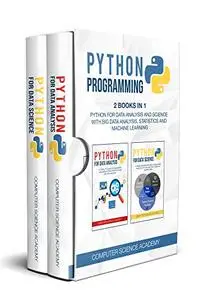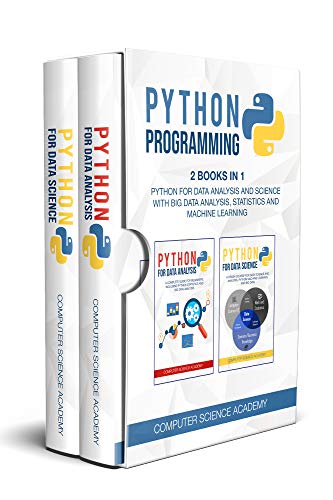Python Programming: 2 Books in 1: Python for Data Analysis and Science with Big Data Analysis, Statistics and Machine Learning by Computer Science Academy
English | March 14, 2020 | ASIN: B085XL3HTZ | AZW3 | 241 pages | 0.8 MB
English | March 14, 2020 | ASIN: B085XL3HTZ | AZW3 | 241 pages | 0.8 MB
If you are looking to master the fundamental concepts of Data Analysis and Data Science driven by the Python programming language to develop a solid understanding of all the latest innovative technologies, then this is just that one comprehensive book you have been waiting for.
If you are looking to learn how to write effective and efficient codes in Python and master this extremely intuitive and flexible programming language that can be used for a variety of coding projects including machine learning algorithms, web applications, data mining and visualization, game development. Then this is just the book that you need. Some of the highlights of this book include:
What the Python language is all about and how we are able to utilize it to get a lot of coding done.
A look at the data analysis and how we can benefit, no matter what industry we are.
How Python is able to work well with the data analysis and why it is the number one language to help you handle this.
A look at some of the steps that we are able to utilize when it comes to our data analysis so we can get it all done the right way.
How to install and use the NumPy library, one of the best extensions with Python, to help us get our data analysis done.
How to work with the Pandas and IPython extensions so that we are able to get things done with your analysis.
The practical uses of the data analysis to help you get it done.
A look at the Matplotlib library to help you create some of your own visuals with your data when the analysis is done.
How to work with data visuals and how they are so important to your work.
The five major stages of the TDSP lifecycle that outline the interactive steps required for project execution along with the deliverables created at each stage.
Installation instructions for Python so you can download and install Python on your operating system and get hands-on coding experience.
Python coding concepts such as data types, classes, and objects variables, numbers, constructor functions, Booleans and much more.
Learn the functioning of various data science libraries like Scikit-Learn, which has evolved as the gold standard for machine learning and data analysis.
Deep dive into the Matplotlib library, which offers visualization tools and science computing modules supported by SciPy and learn how to create various graphs using Matplotlib and Pandas library.
Learn how machine learning allows analysis of large volumes of data and delivers faster and more accurate results.
Overview of four different machine-learning algorithms that can be used to cater to the available data set and create a desired machine-learning model.
Learn how companies are able to employ a predictive analytics model to gain an understanding of customer interactions with their products or services based on customer’s feelings or emotions shared on the social media platforms.
All industries are able to benefit when it comes to working with data analysis and seeing some of the results that you would like. It is not always easy, and it is something that takes longer than many companies are prepared. However, when you are able to put it all together, and you work with the Python language to get it done, you will find that it can provide you with some insights that are invaluable. When you are ready to learn how to complete your own Python data analysis and Python data science, make sure to check out this guidebook to help you get started.
Even if you have never studied Python language before, you can learn it quickly.



